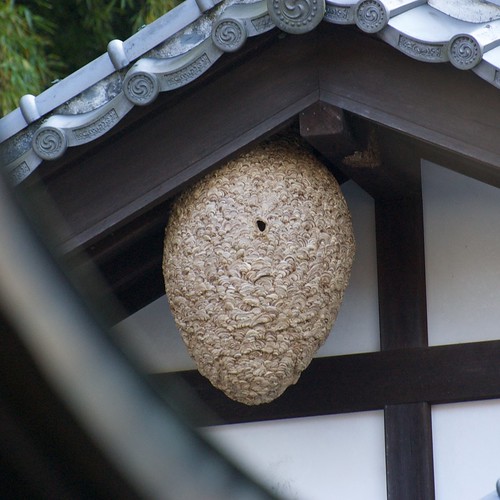Radicalised Buddhism? You'll remember than in September I remarked that there seemed to be a surprisingly large number of the gigantic and potentially deadly Japanese hornets in Kamakura this year.
On Christmas morning we found out why, when we spotted this (probably about 3 foot high? scale) nest tucked under the eaves at Zuisenji (about 1 minute at full speed buzz from our house). I am amazed and somewhat horrified by the Zenwise fortitude that leads the monks to leaves it up there over the winter.
--
Posted By jules to jules' pics at 12/31/2009 10:07:00 PM

2 comments:
Whoah! Impressive:
"In Japan's mountain villages, the hornets are valued as part of the basic diet. They are eaten deep fried, or even as hornet sashimi."
http://news.nationalgeographic.com/news/2002/10/1025_021025_GiantHornets_2.html
Do they overwinter hibernating inside those big paper nests? I can't tell from that article.
I wonder if they're like our N. American bald-faced hornet, which also makes a big globe hanging nest; they're peaceable animals that learn to recognize individuals as unthreatening and leave us alone.
I've had them around my home from time to time. The guard wasps will come hover right in your face a few times (quite possibly memorizing you); if you get too close before you're a known neighbor they'll bounce off you, probably leaving a pheromone targeting tag.
I learned from field biologists to move slowly, steadily passing any of their nests without any sign of aggression, let them identify me, and they have always left me alone.
Of course they're hell on kids who throw rocks.
Our white-faced hornets make a nest only for one year, and have left it by wintertime, so if you don't see activity, that may be the case there.
If you get a chance to open one, they're beautifully structured -- the comb is built underneath the outside paper shell, and the shells when transilluminated are a rainbow of colors reflecting every different wood or fiber source they used in laying the material down.
If yours are like mine, they're rather Buddhist beasts in their own right.
(To be distinguished from our "yellowjacket" that nests underground, and is rather aggressive, especially when claiming picnic lunches and other fat and meat sources)
Best book I know is "Wasp Farm" -- a classic:
http://www.amazon.com/Cornell-Paperbacks-Howard-Ensign-Evans/dp/0801493153
The word for this post is "scinet" -- yep.
Thanks for the info.
I don't think they are really vicious man-eaters, but they do have the reputation of being a bit nastier than most varieties and apparently each year they kill more people here than all the other wildlife put together (we also have brown and black bears, wild boar, poisonous snakes and vicious centipedes).
The Japanese name translates to "sparrow bee", but they aren't quite that big! I don't know for sure but expect that it's just the fertilised queens that overwinter alone and therefore that nest has been abandoned.
Post a Comment